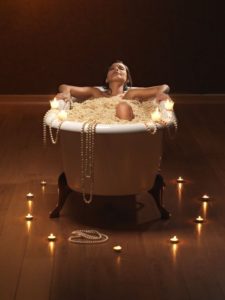Movement has been a through-line all my life. As a kid, I did gymnastics and jazz dance. In junior high, I hosted a dance party themed sleepover. In high school, I was in the marching band’s colorguard. In college, I took ballet and went to the bars with the best music for dancing. After my divorce, I discovered a sober dance party for femme and nonbinary presenting folks, Dance Dance Party Party. Dance has long been an outlet to express myself and a source for healing.
After making a difficult life change, I decided to take a class with the hopes for a happy distraction. Swimming lessons, art classes, and a run club were all considered, but my heart kept nudging me back to dance. After seeing a tap performance in an episode of The Marvelous Mrs. Maisel, I was intrigued. Days later, I discovered a weekly beginner tap class at Old Town School of Folk Music in Chicago with Reggio “The Hoofer.” It was love at first tap.
There’s a reason I picked tap rather than belly dancing or hip hop. There’s something about tap that attracts people who need to shake things up. It’s a little zany. It’s loud. The physical act is cathartic. It’s very, “Here I am! I’m going for it and I don’t care what anyone thinks about it!”
Along the way, I found that I’m not alone. In the media, many female characters, especially white women, are depicted in tap after a major life change. In Sex and the City, Charlotte starts tapping after her divorce and refuses to “go it alone” across the dance floor. Following her husband’s sudden death, Susan Sarandon tap dances at the funeral in the film Elizabethtown. On Friends, Monica goes to a class with Rachel and Phoebe after her credit card is stolen and she questions her life choices. In When Harry Met Sally, Sally is shown taking tap as she figures out how to be single again.
In real life, my classmates are friendly femme-presenting folks, between 30-50 years old. The class is a mix of married women, new moms, and unpartnered people like me. At our recent recital, I asked them why they tap. Every answer was different, but it always came back to joy. A few classmates said they loved tap as a child and wanted it back in their life as an adult. Several have theater backgrounds and missed the thrill of performing. A middle-aged woman who recently moved to Chicago said, “I thought I’d give it a go.” One told me they like to throw themselves out of their comfort zone every few years and learn something new. Another shared, “You know, I just needed to do something for me.” Everyone added, “Plus, it’s fun!”
There are endless resources about the origins of American tap dance, all citing the beginning of tap with enslaved Africans and the indentured Irish, evolving over hundreds of years. Dance provided an outlet for self-expression and maintaining their cultures. American tap is rooted in reclamation of joy and self.
It’s a rebellious act as a woman to make so much noise. Throughout my life, people have told me, “if you don’t have anything nice to say, don’t say anything at all.” Or to be a good girl, to check my attitude, to stop being so dramatic, so sensitive, or so whatever. I don’t want to be a “good girl" anymore. I want to express myself freely. I don’t want to shrink for the comfort of others. At tap, I can be as sassy, dramatic, and loud as I want. At tap, I can be myself.
Me and the women in my life are natural caregivers, leaders, doers, and helpers. We juggle competing priorities, manage endless to-do lists, navigate societal pressures, and challenge our rights that are being taken away. Doing something for ourselves is a radical, but much needed act. Women everywhere, especially women of color, do the bulk of emotional labor, caretaking, and invisible work in every space we occupy. It’s exhausting. Tap is one way I live my freedom now. Once a week, I leave life’s stressors at the door and get to make noise, move my body, laugh, sweat, and learn.
Over time, tap became so much more than a distraction. Through grief, burnout, family issues, a car accident, and a big break up, tap became an anchor. The sense of belonging with my classmates who expect absolutely nothing from me is a gift. The easeful community of friendly peers allows me to be social without much effort. When I’ve had a tough week, I know I have tap to look forward to. Certain steps and combos never fail to put a smile on my face. Every time I put on my tap shoes, I remember that I’m doing something just for me. Tap is one space I don’t care about perfection or being the best. Any time I feel stressed about messing up, I remember that it doesn’t matter. I’m not an aspiring professional tap dancer. I’m not being graded on anything. I have nothing to prove. I’m there to learn something new. I’m there to remind myself I can do hard things. I’m there to move through whatever I’m going through. I’m there for joy. I’m there for me.






